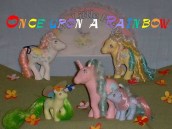Created for the first time in 1982, My Little Pony has been a world-succesful toy for over ten years. Discontinued in the US at the beginning of the 90s, it was still available in Europe, where many exclusive sets were distributed. Officially, the last MLPs of the first generation were a Dutch exclusive set sold in the Netherlands around 1995. In 1997, Hasbro decided to bring ponies back, but the new generation - known as G2 or 97 ponies among collectors - had little in common with the well loved classic ponies: smaller, thinner ponies with jewell-like eyes that were soon discontinued in the USA but not in Europe, where the last sets dates summer 2003.
But this summer's greatest event is the return of MLPs in classic style: a third generation of adorable, chubby, big-headed ponies that makes a succesful mix of modern accents and classic style.
Their biggest innovations are their symbol on the display side only and a magnet in one hoof. A tiny heart symbol usually marks where the magnet is, although the first batch of ponies simply have it on the display side.
Yet, the original MLPs from the 80s remain a timeless classic, with all the different sets made in over ten years and all the different variations available and the different countries of make involved...
At the beginning of the 80s, in fact, Hasbro licensed different factories all over the world to make the ponies that were then distributed in the same country of make or on a larger geographical area. The list includes D.A.G. (ITALY), El Greco (GREECE), Basa (PERU), etc... Later sets were then all made in China and distributed world-wide, with a few exceptions (such as certain late Argentinean sets).
Ponies made in Italy in particular (distributed between 1984 and 1987-88), had a significant role in the European market, providing ponies for the French, German, Belgian, Dutch, and Scandinavian market.
Early American ponies were mostly made in Hong Kong.
Many European sets were never available in the US, and some American ponies never reached the European market. Yet, Europe as a whole had the richest collection of ponies; certain ponies, though, were exclusive of a few specific countries and not available in other areas of Europe, so that there's not a single country in the world where all ponies were available.
Italy in that sense was a blessed country: most ponies from the American line were sold here even when not available in the UK, and at the same time, so were several UK/Euro ponies, not to mention an uber-rare Italian exclusive (made in Italy for the Italian market only) such as alternate Majesty.
So how many ponies are there? Nobody knows. There are around 600 ponies in the American line. This excludes European ponies and most of all, all the early ponies made in countries other than Hong Kong/China. The truth is, we will probably never know. Every year some unknown variation pops up. But that's what makes collecting such an exciting neverending experience... =)

